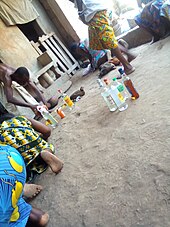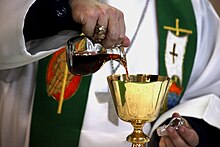Alcoholic beverage
Long-term use can lead to alcoholism, an increased risk of developing several types of cancer, cardiovascular disease, and physical dependence.'[7] Discovery of late Stone Age jugs suggests that intentionally fermented drinks existed at least as early as the Neolithic period.[8] The oldest verifiable brewery has been found in a prehistoric burial site in a cave near Haifa in modern-day Israel.Discovered in 2019 in Carmona, Spain during excavations of the city's western Roman necropolis, analysis of the urn's contents five years after has deemed the vessel the oldest surviving wine in the world, surpassing the previous record holder, the Speyer wine bottle (discovered in 1867) by three centuries.[13] Examination and analysis of ancient pottery jars from the neolithic village of Jiahu in the Henan province of northern China revealed residue left behind by the alcoholic drinks they had once contained.[17] The earliest clear chemical evidence of beer produced from barley dates to about 3500–3100 BCE, from the site of Godin Tepe in the Zagros Mountains of western Iran.[24] In Italy, the works of Taddeo Alderotti (1223–1296) describe a method for concentrating alcohol involving repeated fractional distillation through a water-cooled still.[26] in 1690, England passed "An Act for the Encouraging of the Distillation of Brandy and Spirits from Corn" [27] Alcoholic beverages played an important role in the Thirteen Colonies from their early days when drinking wine and beer at that time was safer than drinking water – which was usually taken from sources also used to dispose of sewage and garbage.Australia's first and only military coup, its name derives from the illicit rum trade of early Sydney, over which the 'Rum Corps', as it became known, maintained a monopoly.Mead (/miːd/), also called hydromel, is an alcoholic drink made by fermenting honey with water, sometimes with various fruits, spices, grains, or hops.Sparkling wines such as French Champagne, Catalan Cava and Italian Prosecco are also made from grapes, with a secondary fermentation.The term hard liquor is used in North America to distinguish distilled drinks from undistilled ones (implicitly weaker).Brandy, gin, mezcal, rum, tequila, vodka, whisky (or wiskey), baijiu, shōchū and soju are examples of distilled drinks.The term neutral refers to the spirit's lack of flavor that would have been present if the mash ingredients had been distilled to a lower level of alcoholic purity.Annual wine festivals celebrate viticulture and usually occur after the harvest of the grapes which, in the northern hemisphere, generally falls at the end of September and runs until well into October or later.Professional organizations like the Wine & Spirit Education Trust often rate beer using verbal grades ranging from "faulty" to "outstanding" on a 1-5 scale.More informal, recreational tasting may involve similar terminology, but with a less analytical process and a more general, personal appreciation of the wine.Where other types of tourism are often passive in nature, enotourism can consist of visits to wineries, tasting wines, vineyard walks, or even taking an active part in the harvest.Wine is important in cuisine not just for its value as an accompanying beverage, but as a flavor agent, primarily in stocks and braising, since its acidity lends balance to rich savory or sweet dishes.[59] Terms for foods always served with alcoholic beverages: Vinegar (vyn egre; sour wine) is an aqueous solution of acetic acid and trace compounds that may include flavorings.In many cultures, wine has had a long history of being a staple at the dinner table and in some ways both the winemaking and culinary traditions of a region will have evolved together over the years.[68][69] A libation is a ritual pouring of a liquid, or grains such as rice, as an offering to a deity or spirit, or in memory of the dead.[71][72] According to Ayi Kwei Armah, "[t]his legend explains the rise of a propitiatory custom found everywhere on the African continent: libation, the pouring of alcohol or other drinks as offerings to ancestors and divinities."[73] In the Quechua and Aymara cultures of the South American Andes, it is common to pour a small amount of one's beverage on the ground before drinking as an offering to the Pachamama, or Mother Earth.[74]The amount of sacramental wine consumed during the Eucharist is typically limited to a single sip or small portion, which does not result in a measurable increase in the participant's blood alcohol content.They also drink them for social events like International Women's Collaboration Brew Day, where people come together to make beer.The most prevalent type of fraud is one where wines are adulterated, usually with the addition of cheaper products (e.g. juices) and sometimes with harmful chemicals and sweeteners (compensating for color or flavor).[84] In Australia, a sly-grog shop (or shanty) is an unlicensed hotel, liquor-store or other vendor of alcoholic beverages, sometimes with the added connotation of selling poor-quality products.A meta analysis of 107 cohort studies concludes low daily alcohol intake provides no health benefits and increased consumption, even at relatively low levels of daily intake (>2 beverages for women and >3 beverages for men), increases health- and mortality-risks.[91] Long-term use can lead to an alcohol use disorder, an increased risk of developing physical dependence, cardiovascular disease, and several types of cancer.


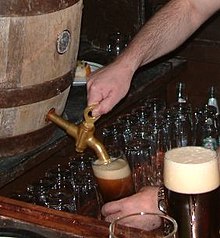


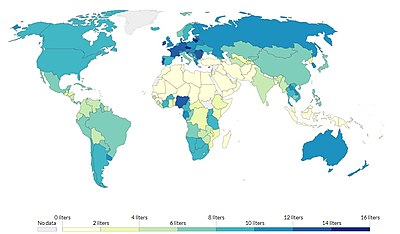

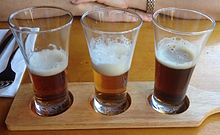
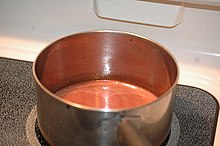

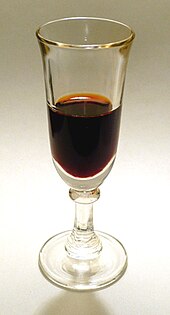



Caffeinated drinkred winemalt whiskysparkling wineliqueurDrinksalcoholspiritsnon-alcoholicdrinking culturepartieswarning labelSome countriesban the consumption of alcoholic drinkstemperance movementalcoholic drink industryrecreational drugsAmericansdepressanteuphoriaanxietydrunkennessstuporunconsciousnessalcoholismseveral types of cancercardiovascular diseasephysical dependencegroup 1 carcinogenWorld Health OrganizationHistory of alcoholic drinksStone AgebreweryIsraelCarmona Wine UrnCarmona, SpainnecropolisSpeyer wine bottlebarleyPliny the EldervineyardspotteryProceedings of the National Academy of ScienceswinemakingGeorgiaSouth CaucasusGodin TepeZagros MountainssymposiaMuslim chemistsJābir ibn ḤayyānAbū Bakr al-Rāzīal-Kindīal-Fārābīal-ZahrāwīMiddle EastTaddeo Alderottifractional distillationEuropean continentIrelandScotlandaqua vitaeThirteen ColoniesWhiskey Rebelliontax protestpresidency of George WashingtonRum Rebellioncoup d'étatpenal colonyNew South WalesNew South Wales CorpsGovernorWilliam BlighSydneyalcohol monopolyprofit motiveSwedish parliamentRussian EmpireUnited StatesUnited KingdomCanadaScandinaviain Canadathe United Statesin IndiaSchlenkerlasmoked beerbeer glassBeer stylesList of beer stylesspiritfermentedfruit juiceapple juicepeachesapple wineethanolsweet reservewhite sugarfruitsspicesgrainsPulqueMesoamericanmagueyAgave americanatequilaMezcalRice winedistilledEast AsiaSoutheast AsiaSouth AsiahuangjiucheongjuEast AsianGlasseswhite winegrapesaging processSparkling winesFrenchChampagneCatalanItalianProsecco
